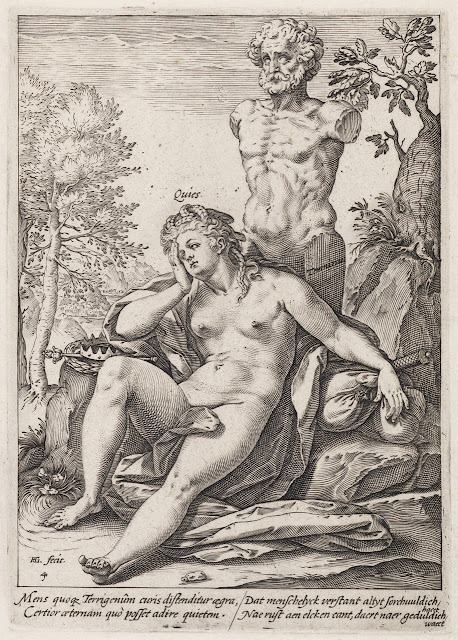 |
| Jonas Suyderhoef Portrait of Hendrik Goltzius within figural cartouche before 1686 engraving Teylers Museum, Haarlem |
 |
| Hendrik Goltzius Personification of Art and Application 1582 engraving Teylers Museum, Haarlem |
 |
| Hendrik Goltzius Personification of Honor and Riches 1582 engraving Teylers Museum, Haarlem |
 |
| Hendrik Goltzius Personification of Labor and Diligence 1582 engraving Teylers Museum, Haarlem |
 |
| Hendrik Goltzius Personification of Repose 1582 engraving Teylers Museum, Haarlem |
"Hendrik Goltzius, who was born in the Lower Rhine region of Germany, came from a long line of artists: his great-grandfather and grandfather were both painters in Venlo, and his father, Jan Goltz II (1534-after 1609), was a glass painter in Duisburg. The art theorist Karel van Mander I (Netherlandish, 1548-1606), who is the primary source of information about Goltzius and his work, notes that Goltzius was apprenticed to the printmaker Dirck Volckertz Coornhert (Netherlandish, 1522-1590) and moved with his teacher from Xanten to Haarlem shortly after 1576. Goltzius married the widow Margaretha Jansdr in 1579. Margaretha came into the marriage with an eight-year-old son, Jacob Matham (1571-1631), who later studied with Goltzius and became a printmaker in his own right."
"Goltzius was renowned as a graphic artist and produced prints and drawings using a variety of techniques, including metalpoint, brush and ink, and chalk. He was also a pioneer in the art of "pen-painting," a technique he invented in which pen is used directly on canvas to mimic the look of a print. Goltzius impressed his contemporaries with these large, monochromatic works, which were admired for their high degree of detail and innovative process of execution."
"Goltzius' early works from the late 1580s reflect the influence of international mannerism, a style characterized by long, attenuated figures and highly dramatic compositions, promulgated by the artist Bartholomeus Spranger (Flemish, 1546-1611). court painter to Emperor Rudolf II in Prague. Goltzius made engravings after Spranger's drawings, which Van Mander brought to him from Prague. In October of 1590 Goltzius traveled to Italy and he stayed there for six months. While in Rome, Goltzius studied antique sculpture and, as a consequence, his art became much more classicizing in style and grounded in the study of the human body."
"In about 1600 Goltzius added painting to his already long list of talents. It has been speculated that the artist's failing eyesight played a part in his decision to begin painting, which did not require the precision of printmaking. It is possible, however, that his decision was prompted by his friend and biographer Van Mander, for whom painting was the highest form of art. In 1612 Goltzius was visited by Sir Peter Paul Rubens (Flemish, 1577-1640) who had come to the Haarlem master in search of a reproductive engraver to make prints after his paintings. Rubens hired Lucas Emil Vorsterman (Flemish, 1595-1675), one of Goltzius' assistants, to fulfill this role. Rubens' visit had an important impact on Goltzius' painting style, which subsequently became more assured and classical in character."
– biographical notes (2014) from the National Gallery of Art by Arthur K. Wheelock Jr.
 |
| Hendrik Goltzius Standing young man with walking stick ca. 1588 chiaroscuro woodcut Teylers Museum, Haarlem |
 |
| Hendrik Goltzius Proserpina 1594 chiaroscuro woodcut Metropolitan Museum of Art, New York |
 |
| Hendrik Goltzius Arcadian Landscape ca. 1597-98 chiaroscuro woodcut Teylers Museum, Haarlem |
 |
| Hendrik Goltzius Landscape with a waterfall ca. 1592-95 chiaroscuro woodcut National Gallery of Art, Washington DC |
 |
| Hendrik Goltzius Landscape with seated couple ca. 1595-1617 chiaroscuro woodcut Metropolitan Museum of Art, New York |
 |
| Hendrik Goltzius Massacre of the Innocents ca. 1584 engraving Teylers Museum, Haarlem |
 |
| Hendrik Goltzius Siamese Twins 1579 engraving Teylers Museum, Haarlem |
 |
| Hendrik Goltzius Dead Christ with the Four Evangelists 1583 engraving Teylers Museum, Haarlem |
 |
| Hendrik Goltzius Venus and Cupid 1583 engraving Teylers Museum, Haarlem |